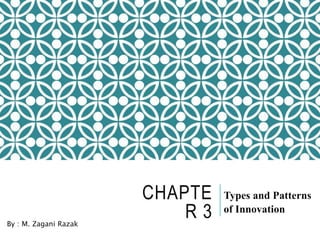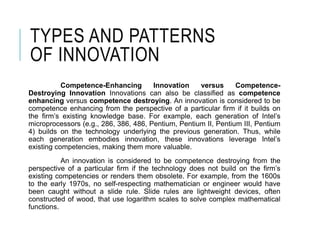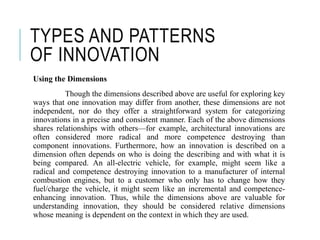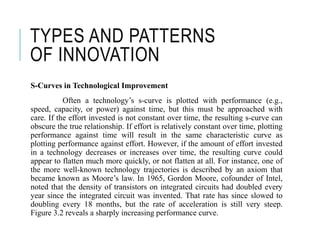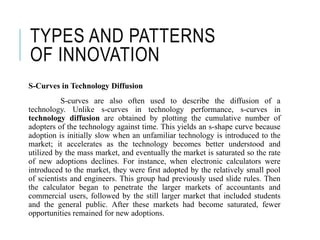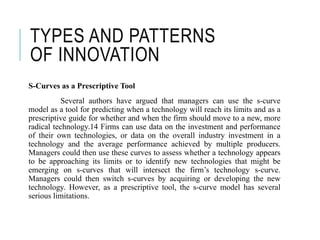Chapter 3
- 1. CHAPTE R 3 Types and Patterns of Innovation By : M. Zagani Razak
- 2. TYPES AND PATTERNS OF INNOVATION Product Innovation versus Process Innovation Product innovations are embodied in the outputs of an organization-ts goods or services. For example, Honda’s development of a new hybrid electric vehicle is a product innovation. Process innovations are innovations in the way an organization conducts its business, such as in the techniques of producing or marketing goods or services. Process innovations are often oriented toward improving the effectiveness or efficiency of production by, for example, reducing defect rates or increasing the quantity that may be produced in a given time. For example, a process innovation at a biotechnology firm might entail developing a genetic algorithm that can quickly search a set of disease-related genes to identify a target for therapeutic intervention. In this instance, the process innovation (the genetic algorithm) can speed up the firm’s ability to develop a product innovation (a new therapeutic drug).
- 3. TYPES AND PATTERNS OF INNOVATION Competence-Enhancing Innovation versus Competence- Destroying Innovation Innovations can also be classified as competence enhancing versus competence destroying. An innovation is considered to be competence enhancing from the perspective of a particular firm if it builds on the firm’s existing knowledge base. For example, each generation of Intel’s microprocessors (e.g., 286, 386, 486, Pentium, Pentium II, Pentium III, Pentium 4) builds on the technology underlying the previous generation. Thus, while each generation embodies innovation, these innovations leverage Intel’s existing competencies, making them more valuable. An innovation is considered to be competence destroying from the perspective of a particular firm if the technology does not build on the firm’s existing competencies or renders them obsolete. For example, from the 1600s to the early 1970s, no self-respecting mathematician or engineer would have been caught without a slide rule. şÝşÝߣ rules are lightweight devices, often constructed of wood, that use logarithm scales to solve complex mathematical functions.
- 4. TYPES AND PATTERNS OF INNOVATION Architectural Innovation versus Component Innovation An innovation is considered a component innovation (or modular innovation) if it entails changes to one or more components, but does not significantly affect the overall configuration of the system.In the example above, an innovation in bicycle seat technology (such as the incorporation of gel-filled material for additional cushioning) does not require any changes in the rest of the bicycle architecture. In contrast, an architectural innovation entails changing the overall design of the system or the way that components interact with each other. An innovation that is strictly architectural may reconfigure the way that components link together in the system, without changing the components themselves.6 Most architectural innovations, however, create changes in the system that reverberate throughout its design, requiring changes in the underlying components in addition to changes in the ways those components interact. Architectural innovations often have far- reaching and complex influences on industry competitors and technology users.
- 5. TYPES AND PATTERNS OF INNOVATION Using the Dimensions Though the dimensions described above are useful for exploring key ways that one innovation may differ from another, these dimensions are not independent, nor do they offer a straightforward system for categorizing innovations in a precise and consistent manner. Each of the above dimensions shares relationships with others—for example, architectural innovations are often considered more radical and more competence destroying than component innovations. Furthermore, how an innovation is described on a dimension often depends on who is doing the describing and with what it is being compared. An all-electric vehicle, for example, might seem like a radical and competence destroying innovation to a manufacturer of internal combustion engines, but to a customer who only has to change how they fuel/charge the vehicle, it might seem like an incremental and competence- enhancing innovation. Thus, while the dimensions above are valuable for understanding innovation, they should be considered relative dimensions whose meaning is dependent on the context in which they are used.
- 6. TYPES AND PATTERNS OF INNOVATION S-Curves in Technological Improvement Often a technology’s s-curve is plotted with performance (e.g., speed, capacity, or power) against time, but this must be approached with care. If the effort invested is not constant over time, the resulting s-curve can obscure the true relationship. If effort is relatively constant over time, plotting performance against time will result in the same characteristic curve as plotting performance against effort. However, if the amount of effort invested in a technology decreases or increases over time, the resulting curve could appear to flatten much more quickly, or not flatten at all. For instance, one of the more well-known technology trajectories is described by an axiom that became known as Moore’s law. In 1965, Gordon Moore, cofounder of Intel, noted that the density of transistors on integrated circuits had doubled every year since the integrated circuit was invented. That rate has since slowed to doubling every 18 months, but the rate of acceleration is still very steep. Figure 3.2 reveals a sharply increasing performance curve.
- 7. TYPES AND PATTERNS OF INNOVATION S-Curves in Technology Diffusion S-curves are also often used to describe the diffusion of a technology. Unlike s-curves in technology performance, s-curves in technology diffusion are obtained by plotting the cumulative number of adopters of the technology against time. This yields an s-shape curve because adoption is initially slow when an unfamiliar technology is introduced to the market; it accelerates as the technology becomes better understood and utilized by the mass market, and eventually the market is saturated so the rate of new adoptions declines. For instance, when electronic calculators were introduced to the market, they were first adopted by the relatively small pool of scientists and engineers. This group had previously used slide rules. Then the calculator began to penetrate the larger markets of accountants and commercial users, followed by the still larger market that included students and the general public. After these markets had become saturated, fewer opportunities remained for new adoptions.
- 8. TYPES AND PATTERNS OF INNOVATION S-Curves as a Prescriptive Tool Several authors have argued that managers can use the s-curve model as a tool for predicting when a technology will reach its limits and as a prescriptive guide for whether and when the firm should move to a new, more radical technology.14 Firms can use data on the investment and performance of their own technologies, or data on the overall industry investment in a technology and the average performance achieved by multiple producers. Managers could then use these curves to assess whether a technology appears to be approaching its limits or to identify new technologies that might be emerging on s-curves that will intersect the firm’s technology s-curve. Managers could then switch s-curves by acquiring or developing the new technology. However, as a prescriptive tool, the s-curve model has several serious limitations.
